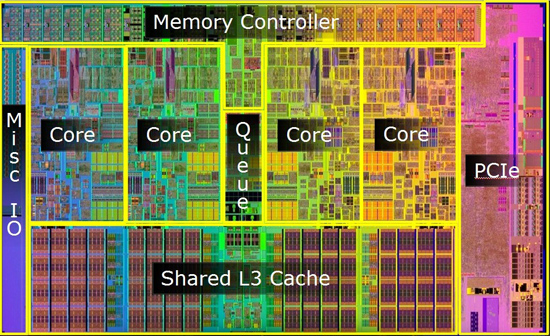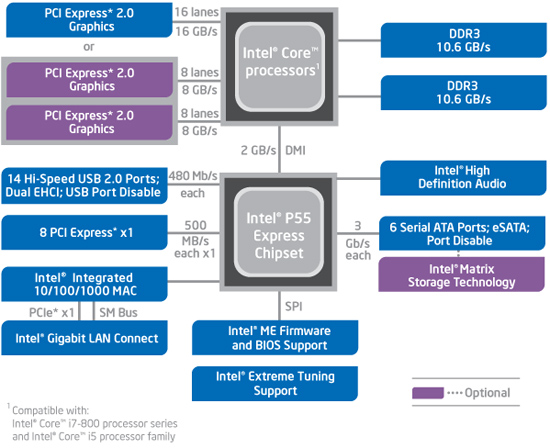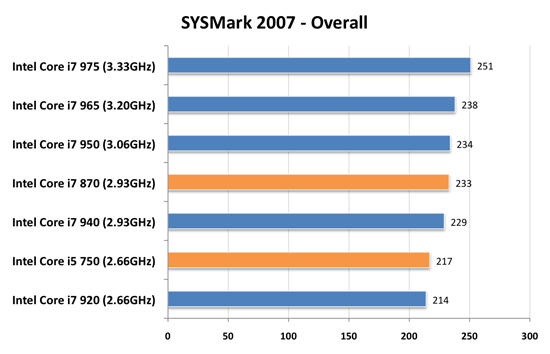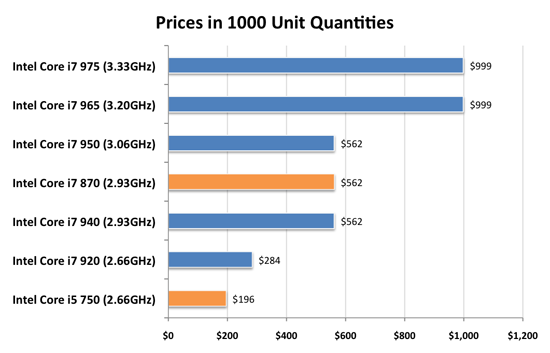Intel's Core i7 870 & i5 750, Lynnfield: Harder, Better, Faster Stronger
by Anand Lal Shimpi on September 8, 2009 12:00 AM EST- Posted in
- CPUs
Intel is on the verge of transitioning to 32nm. We'll see the first parts this year. What do you do with your 45nm fabs when you start moving volume away from them? Make really cheap quad-core Nehalems of course:

I'm talking $196. I'm talking faster than AMD's entire lineup. I'm talking about arguably the best processor of 2009. I'm talking about Lynnfield, and here's its backside:

Mmm
I spent much of the past year harping on AMD selling Nehalem-sized Phenom IIs for less than Intel sold Nehalems. With Lynnfield, Intel actually made Nehalem even bigger all while driving prices down. Like I said, what do you do when you're still making boatloads of money in a recession and are about to start emptying your 45nm fabs?
I should clear things up before we progress much further. Lynnfield is the codename for mainstream 45nm quad-core Nehalem, while Bloomfield refers to the first Nehalem launched at the end of 2008:
| Processor | Manufacturing Process | Die Size | Transistor Count | Socket |
| Bloomfield | 45nm | 263 mm2 | 731M | LGA-1366 |
| Lynnfield | 45nm | 296 mm2 | 774M | LGA-1156 |
Despite being cheaper, Lynnfield is larger than Bloomfield. The larger die is due to one major addition: an on-die PCIe controller.

Bloomfield, The First Nehalem, circa 2008

Lynnfield, Nehalem for All, circa 2009
The pink block to the right of the die is the PCIe controller, that's 16 PCIe 2.0 lanes coming right off the chip. Say hello to ultra low latency GPU communication. You'd think that Intel was about to enter the graphics market or something with a design like this.
Sacrifices were made to reduce CPU, socket and board complexity. Gone are the two QPI links that each provided 25.6GB/s of bandwidth to other CPUs or chips on the motherboard. We also lose one of the three 64-bit DDR3 memory channels, Lynnfield only has two like a normal processor (silly overachieving Bloomfield).

Intel's Bloomfield Platform (X58 + LGA-1366)
The sum is that Lynnfield is exclusively single-socket; there will be no LGA-1156 Skulltrail. While the dual-channel memory controller isn't really a limitation for quad-core parts, six and eight core designs may be better suited for LGA-1366.

Intel's Lynnfield Platform (P55 + LGA-1156)
The loss of QPI means that Lynnfield doesn't have a super fast connection to the rest of the system, but with an on-die PCIe controller it doesn't matter: the GPU is fed right off the CPU.
The Lineup
We get three Lynnfield CPUs today: the Core i7 870, Core i7 860 and the Core i5 750. Intel's branding folks told us that the naming would make sense one we saw the rest of the "Core" parts introduced; yeah that was pretty much a lie. At least there aren't any overlapping part numbers (e.g. Core i5 860 and Core i7 860).
The i7 in this case denotes four cores + Hyper Threading, the i5 means four cores but no Hyper Threading. The rules get more complicated as you bring notebooks into the fray but let's momentarily bask in marginal simplicity.
| Processor | Clock Speed | Cores / Threads | Maximum Single Core Turbo Frequency | TDP | Price |
| Intel Core i7-975 Extreme | 3.33GHz | 4 / 8 | 3.60GHz | 130W | $999 |
| Intel Core i7 965 Extreme | 3.20GHz | 4 / 8 | 3.46GHz | 130W | $999 |
| Intel Core i7 940 | 2.93GHz | 4 / 8 | 3.20GHz | 130W | $562 |
| Intel Core i7 920 | 2.66GHz | 4 / 8 | 2.93GHz | 130W | $284 |
| Intel Core i7 870 | 2.93GHz | 4 / 8 | 3.60GHz | 95W | $562 |
| Intel Core i7 860 | 2.80GHz | 4 / 8 | 3.46GHz | 95W | $284 |
| Intel Core i5 750 | 2.66GHz | 4 / 4 | 3.20GHz | 95W | $196 |
Keeping Hyper Threading off of the Core i5 is purely done to limit performance. There aren't any yield reasons why HT couldn't be enabled.
Intel was very careful with both pricing and performance of its Lynnfield processors. I'm going to go ahead and say it right now, there's no need for any LGA-1366 processors slower than a Core i7 965:

This is only one benchmark, but it's representative of what you're about to see. The Core i7 870 (LGA-1156) is as fast, if not faster, than every single LGA-1366 processor except for the ones that cost $999. Its pricing is competitive as well:

For $196 you're getting a processor that's faster than the Core i7 920. I'm not taking into account motherboard prices either, which are anywhere from $50 - $100 cheaper for LGA-1156 boards. I don't believe LGA-1366 is dead, but there's absolutely no reason to buy anything slower than a 965 if you're going that route.










343 Comments
View All Comments
moronsworld - Saturday, September 26, 2009 - link
To all you morons that don't understand economics. amd gone = intel monopoly = intel processors overpriced. Plain and simple. Take an economy class or 2, you morons. AMD is a good company, just that Intel's processors are better at the moment. God too many morons in this world that are allowed to vote. We live in a society ruled by morons.TA152H - Tuesday, September 8, 2009 - link
Actually, you don't really know what you're talking about.On-die memory controllers are nothing new. The Nexgen 586 had it in the mid-90s. Intel just knew when to add it, and when not to. That's why the Core 2 blows AMD processors away, while being significantly smaller.
AMD instruction schedulers were behind Intel's Pentium Pro from 1995 until the Phenom II came out. It still doesn't have full memory disambiguation like Intel introduced with the Core 2, but at least the memory scheduling is now on par with the Pentium Pro. I'm not sure that something they like brought up though.
64-bit processing is also old hat, and really was just an extension of the 386 protected mode anyway, with a lot of Microsoft input.
The K8 wasn't really much of an architecture, it was a K7 with a memory controller, and a couple of extra stages for better IPC, that most idiots thought was for higher clock speeds. It was a failure, and was what put AMD in the situation where they are now. It was, generally, better than the Netburst, but then, is that such a high bar to get over? The problem was, they actually believed it was a good processor until the Core 2 relieved them of that misapprehension. The reality is, Intel's mobile chips were always better than the K8, but the damn fools made us buy the Pentium 4 for the desktop. To AMD's credit, at least they never made anything horrible like that, but, really, their primary claim to fame was based more on the terrible Intel design than a great processor of their own, and the fact Intel wouldn't let us use the mobile chips for desktops.
JonnyDough - Tuesday, September 8, 2009 - link
Please work on your English before replying to me in the future. Thanks.Aenslead - Tuesday, September 8, 2009 - link
So you *must* have perfect english to reply in these forums?Gosh, never saw that in the Terms and Conditions agreement when I created my account. So that means that anybody (or a nobody, like you) have a say on what other races and people from other countries that don't speak English as their first language, that LIKE READING and giving their opinion in a FREE MOFO OPEN FORUM, must do to post here?
You and your kind are pathetic.
JonnyDough - Tuesday, September 8, 2009 - link
I didn't say anything about having perfect English. You sir, are a troll. I just wanted his reply to be coherent. This is the ENGLISH version of DailyTech, there are other language versions. His post didn't even make sense, and yours was just trolling.ginbong - Wednesday, September 9, 2009 - link
I understood what he said, maybe you need to sharpen up your analytical skills and stop being a dlckhead on this hardware analysis website.Better yet, how about taking the money you have saved for your next PC upgrade and enrolling into Grade 1 again.
dastruch - Tuesday, September 8, 2009 - link
and you don't get it too... patheticjigglywiggly - Tuesday, September 8, 2009 - link
This is a hot cpu, except I want 6 cores + HT. 32nm... quads ahh yeah. I still don't like the i5, because I don't want two sockets on one brand at the same time. It just limits options, I am only looking at i7/i9, because I bought this qx6700 in 2006 for 1000$. It was a good purchase, because q6600s were a while away and they were 500$. I got my qx6700 to 3.85ghz, now it's at 3.5ghz stable. Curse you electromigration! Also curse you economy! I don't have enough money for a 6core+6HT 1000$ cpu again.JonnyDough - Tuesday, September 8, 2009 - link
*Laughs at the moron...Go buy a Ferrari and then wreck it and sell it for parts. That's essentially a larger scale version of what you did.
Lifted - Tuesday, September 8, 2009 - link
Huh? Buying a $1000 CPU is like wrecking a Ferrari?"Laughs at the moron"